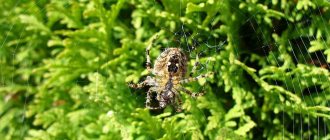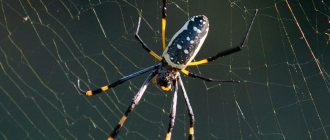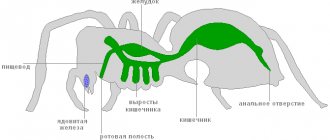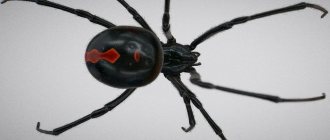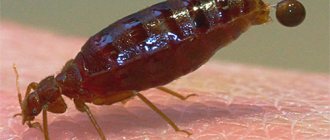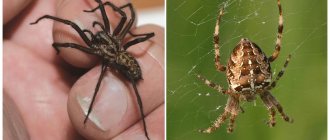Molting in a tarantula
Molting is the replacement of an old exoskeleton with a new one, in other words, the replacement of “skin”.
This is a very important period in the life of a spider, with the help of it the Tarantula grows. Within a few days, and sometimes weeks (depending on age), the spider stops feeding. Becomes inactive and may stay in one position for 24 hours. This is the so-called preparatory period. At the end of this period, the exposed area of the abdomen changes color from light to almost black; the old skeleton begins to peel off and a new one begins to emerge under it. Next, the spider weaves a “bed” for itself, this is a rug made of cobwebs. Making the bedding takes about 2-4 hours. After this, the tarantula lies down on it upside down and lies there for a short time. (Some individuals molt on their sides and even when not upside down) Then the “skin” bursts, and the spider gradually, pulling out its legs, frees itself from the old skeleton. This period can last from several minutes to several hours, also depending on the age of the Tarantula.
The older the spider, the longer this period. Next, the spider, continuing to lie on its back, straightens its limbs, moving them alternately. Having dried a little, it turns over. The new skeleton will still harden within a few days. The tarantula will not start feeding soon, from one week to 2-3 months. During all periods of molting, touching the spider, much less picking it up, is strictly prohibited. Even a small grain of sand, at the moment of release from the old skeleton, can cause damage to the Tarantula. It is also necessary to ensure that there are no food insects left in the terrarium, which can easily damage it. Mites are also a threat to the spider during the molting process.
Old skin is called exuvium. Do not remove it from the terrarium until the Tarantula rolls over to its feet, but do not leave it for long. An old skeleton makes good stuffed animals, provided the spider is an adult, of course. A little patience and you will have a nice collection. You can also easily determine the sex of a spider by looking at its skin, even at a relatively young age.
Spiders molt at different intervals. Young ones can change the skeleton every two weeks or a little more often. Adults molt every year, sometimes once every one and a half, two years, but this is already rare, only with very old individuals.
A very important feature of the tarantula's molting is the ability to regenerate, i.e. restoration of lost limbs. If a spider, for some reason, has lost one leg, then within three to four molts it will be completely restored. In our practice, there was a case of restoration of four limbs at once. The tarantula could not even feed on its own. He was fed from tweezers! He is doing great now! The tarantula's bristles are also restored. A spider with a completely bald abdomen becomes shaggy and beautiful again.
During the molting process, problems may arise; the spider may not be able to free one or more legs or even enter this stage. This happens because there were, let’s say, flaws in its content. Insufficient humidity is the main reason for unsuccessful molting. But high humidity can also be a problem.
The more molts a spider has, the older it naturally is. Mark each period, keep a small diary, this may be useful to you. Many Tarantula collectors will tell you the age of a young spider not in months or weeks, but in moults, as this is more accurate. The periods between moults greatly depend on the way the Tarantula is kept. Namely, temperature, abundance of food, etc. The higher the temperature, the faster the spider grows. But don’t overdo it, I think 30-32 degrees is the limit.
How many spider Arctosa Fulvolineata
Can you stay underwater without drowning? To find out, Julien Pétillon from the University of Rennes dipped the arthropods into water, waited until they stopped showing signs of life, and pulled them out of the vessel onto land. However, a little later, the entomologist discovered that the seemingly dead spiders began to come to their senses.
A.
Fulvolineata are known for their ability to withstand submersion in water. Therefore, Julien was not very surprised that it took almost a day to wait for the “death” of the spiders. Apparently, in order to conduct further research, the scientist decided to dry out the unfortunate experimental subjects.
Imagine his surprise when, one after another, the arthropods gradually returned to life. It was as if they had been in a coma before.
“We didn’t expect that spiders could go into this state,” explains Pétillon.
As a result of further research, it turned out that individual representatives of A.
What is shedding
Molting is a very common phenomenon in the life of animals. Some people shed their fur and feathers (more about molting in birds), while others shed their old exoskeleton and put on new skin. A distinctive feature of spider molting is that during the molting period the spider... grows. His old skin is becoming too small for him, and in order to feel comfortable, he needs a new exoskeleton.
If for some reason your young spider has not shed for a long time, it means that it has problems with growth, and you should reconsider its conditions of detention...
Molting in tarantulas
Fulvolineata calmly survive even a 40-hour stay in water.
Julien and his colleagues explain what is happening this way: in the absence of oxygen, spiders switch their metabolism from aerobic to anaerobic (oxygen-free) mode.
On average, all individuals were able to survive without air for about 16 hours.
Scientists believe that this is due to the lifestyle of A. fulvolineata
(after all, their forest counterparts of the species
Pardosa purbeckensis
did not last even part of this time).
“Many species of spiders live in places where they have to dive underwater from time to time.
In most cases of flooding, arthropods simply climb up the available plants, but we have never seen spiders manage to “endure” under water for so long,” says Pétillon.
We are, of course, not talking about those arthropods that are able to drag air with them under water (for some it lingers on the shell, others weave special scuba nets).
The period of 16 hours may be due to the fact that in the salt marshes of northwestern France (in the area where A.
Fulvolineata) hot flashes rarely last more than eight hours. And it is even more unlikely that the spiders will wait for two such arrivals of high water.
There is an opinion that spiders developed their ability to weave webs specifically for protection from the water elements.
By making a waterproof “door” for their home, they could easily wait out floods or long rains. A. fulvolineata
indirectly confirm this theory.
They almost never create silk threads, and with their incredible endurance they don’t really need it.
The article by the authors of the work will be published in the journal Biology Letters.
Arachnids do not have an internal skeleton, but have an external one - an exoskeleton. Muscles, ligaments and internal organs are attached to it.
This is a hard body covering consisting of chitin and sclerotin. It consists of strong and hard areas, thin, soft and elastic areas, as well as tactile hairs.
The exoskeleton cover itself is called the cuticle.
The exoskeleton does not grow with the animal, so during the life of arachnids it undergoes a natural change - molting. The shed exoskeleton of a spider is called an exuvium.
Conventionally, molting can be divided into several stages:
- premolting - the formation of a new exoskeleton under the old one;
- molting itself is a change of exoskeleton;
- postmolting - restoration of the exoskeleton.
Precautions during shedding
This is a crucial period for any arachnoid breeder, since the life of your pet and the successful outcome of the molt will depend on the conditions you create.
The first thing you should pay attention to is the humidity and temperature in the terrarium. The duration of all stages of molting depends on temperature. At low temperatures (below 22°C) they will take much longer.
It is also better not to make the temperature too high; it should be in the range of 22-28°C, depending on the type.
The humidity should be raised immediately before molting so that the animal does not dry out during molting, as it loses a lot of moisture.
To do this, you need to place a wide drinker and constantly moisten half of the substrate in the terrarium (for moisture-loving species), or only one corner (for dry-loving species).
Lack of moisture can cause limbs to get stuck in the exuvia. In this case, the spider itself amputates them. During the next molt, a new, small and practically hairless limb grows in place of the lost limb. After 2-4 moults, the limb is completely restored. Scorpions regenerate lost limbs more slowly and often remain without them for life.
There may also be incomplete separation of the abdomen skin, and the spider is left with a dried “patch”.
You can try to remove it when the spider is already moving and cleaning itself. Earlier, the soft lining of the abdomen can be damaged.
Before and after molting, spiders and scorpions do not feed, so uneaten food must be removed.
Shedding
When the molting stage begins, the tarantula spider rolls over onto its back. Exuvial fluid begins to secrete between the old hard and new soft exoskeleton. This is a kind of lubricant designed to slightly soften the old shell.
The molting of a tarantula spider, photos of which are often posted online by owners, begins with the creation of excess pressure inside the shell. The process is poorly understood, and how this happens to the end has not been established. The old skeleton bursts and the spider begins to release the cephalothorax. Then the membrane on the abdomen bursts.
Next, the spider's molting continues with the gradual release of its appendages. These are paws, pedipalps, chelicerae. For the tarantula, this is the most difficult moment; if the appendage cannot be released, the spider is forced to discard it. The shedding of the old exoskeleton is accompanied by wave-like contractions of the muscles of the back of the body.
Molting in tarantulas
Leaving crickets, cockroaches and other insects in the terrarium during molting is very dangerous, as they can damage (gnaw) your pet when it is soft and completely defenseless after changing its exoskeleton.
During all stages of molting, animals should be left alone and not touched with hands. It is especially dangerous to take them immediately after molting. Since the covers are soft, any careless movement can cause them to rupture.
Also, do not touch the spider’s exuvium until it takes it out of the nest. Exuvium can be taken only in extreme cases, for example, to determine sex.
You can feed your pets after molting only when the recovery period is over (see timings below).
You need to be careful with large spiders - if fed ahead of time, they sometimes die. This is especially true for large and voracious species - Theraphosa, Pamphobeteus, Lasiodora and others. It is better to wait a few more days to feed. To understand whether a spider can already hunt and eat, you need to throw live food near it. If the spider reacts by instantly rushing over and grabbing the food, and immediately starts eating, then everything is fine, it has already recovered.
If the spider hesitantly grabs the food or runs away from it, then it’s not time yet.
Molting of tarantula spiders.
The most common question that comes up is when will my spider molt?
Preparation for molting, or the stage of formation of a new exoskeleton (premolt), is usually noticeable by the following signs. The spider is quite well-fed (not always) and stops eating and does not respond to food.
The spider's integument becomes dull and becomes noticeably darker in light-colored specimens. The darkening is especially noticeable on the abdomen, where the spider has scratched off the hairs. The spider becomes inactive and tries to hide.
Just before molting, the spider weaves a mat of web if it is a terrestrial species, or closes the entrance to the nest if it is an arboreal species, and burrowing species also weave the entrance to the burrow.
The molt itself goes like this.
The spider lies on its back and remains in this position from an hour to a day. (There are exceptions - some spiders molt on their sides or vertically on the web.) At this time, its new exoskeleton separates from the old one, and the liquid between them softens the tough cuticle so that the spider can crawl out of its shell.
Molting begins with the bursting of the cuticle between the chelicerae and the cephalothorax. The spider gradually climbs out through this gap - first it extends the cephalothorax with chelicerae, then the abdomen and legs.
After he finally gets out of the old exoskeleton, he lies on his back for some time, with his legs bent. Then he begins to move his legs little by little, bending and unbending them. They still don’t listen to him well, as they are very soft and gentle.
Post-molting stage.
The spider turns over on its belly and sits huddled into a ball. Exuvium lies nearby. Spiders often chew the soft cuticle of the exuvium in the abdomen area. It contains a lot of moisture, and thus the spider replenishes its loss during molting. Then the spider stretches out and lies there for a long time - its new cover stretches, and the internal organs straighten out. After molting, the spider cleans itself, stretches, but moves little and lies almost in one place.
Within a few days, its integument hardens and the internal organs restore their functions. And he can walk, run, hunt and eat again. There is no need to feed the spider until the recovery (post-molting) stage is completed; it will run away from the food.
A few hours or days after molting, the spider removes the exuvium from its nest. It is easy to determine the gender of the spider. If the exuvium has dried out, then it needs to be soaked in water and the lower part of the abdomen is straightened.
Usually the spider damages this part the most when it chews its former exoskeleton.
On the abdomen you need to find the epigastric region - the space between the first pair of lungs. If there is a spermatheca - a special pocket of their hard cuticle of a special shape (it determines the spider’s species), then this is a female.
If there is no spermatheca, but on the epigastric region there is a dark spot in the form of an arch, then it is a male.
Particular attention should be paid to the presence of the cuticle lining the spider's sucking stomach. The pet's life may depend on it. A spider that does not replace this cuticle will not be able to feed normally.
This part of the exoskeleton is located inside, at the location of the mouth, and is an elongated “process”.
Spiders of different ages spend different times molting. The numbers are approximately the same.
- If the spider has 1-3 moults, then the pre-molting stage lasts 4-7 days, molting takes place in 15-30 minutes, the post-molting stage lasts 4-7 days, molting once every 3-5 weeks.
- Spider 4-7 molting: pre-molting stage - 5-10 days, molting - 30-60 minutes, post-molting stage - 5-10 days, molting once every 4-8 weeks.
- Spider 8-10 molting: pre-molting stage - 10-15 days, molting - 1-4 hours, post-molting stage - 10-15 days, shedding once every 3-6 months.
- Spider 11-13 molting: pre-molting stage - 14-25 days, molting - 3-12 hours, post-molting stage - 14-25 days, molting once every 6-12 months.
- Spiders older than 14 molts (adult females): pre-molting stage - 20-30 days, molting - 10-36 hours, post-molting stage - 20-30 days, molts once every 1-3 years.
- Males that have reached sexual maturity (signs are bulbs on the pedipalps and tibial hooks on the first pair of legs) no longer molt and live 1-3 years.
Although there are exceptions when adult males molt, they usually either die during the molt or lose the pedipalps, since the bulbs prevent them from being pulled out of the exuvium.
Molting is the replacement of an old exoskeleton with a new one, in other words, the replacement of “skin”. This is a very important period in the life of a spider, with the help of it the Tarantula grows.
Within a few days, and sometimes weeks (depending on age), the spider stops feeding. Becomes inactive and may stay in one position for 24 hours. This is the so-called preparatory period. At the end of this period, the exposed area of the abdomen changes color from light to almost black; the old skeleton begins to peel off and a new one begins to emerge under it. Next, the spider weaves a “bed” for itself, this is a rug made from cobwebs.
Making the bedding takes about 2-4 hours. After this, the tarantula lies down on it upside down and lies there for a short time. (Some individuals molt on their sides and even when not upside down) Then the “skin” bursts, and the spider gradually, pulling out its legs, frees itself from the old skeleton. This period can last from several minutes to several hours, also depending on the age of the Tarantula.
The older the spider, the longer this period. Next, the spider, continuing to lie on its back, straightens its limbs, moving them alternately. Having dried a little, it turns over. The new skeleton will still harden within a few days. The tarantula will not start feeding soon, from one week to 2-3 months.
During all periods of molting, touching the spider, much less picking it up, is strictly prohibited. Even a small grain of sand, at the moment of release from the old skeleton, can cause damage to the Tarantula.
It is also necessary to ensure that there are no food insects left in the terrarium, which can easily damage it. Mites are also a threat to the spider during the molting process. Old skin is called exuvium.
Do not remove it from the terrarium until the Tarantula rolls over to its feet, but do not leave it for long. An old skeleton makes good stuffed animals, provided the spider is an adult, of course.
A little patience and you will have a nice collection. You can also easily determine the sex of a spider by looking at its skin, even at a relatively young age.
Spiders molt at different intervals. Young ones can change the skeleton every two weeks or a little more often. Adults molt every year, sometimes once every one and a half, two years, but this is already rare, only with very old individuals.
A very important feature of the tarantula's molting is the ability to regenerate, i.e. restoration of lost limbs. If a spider, for some reason, has lost one leg, then within three to four molts it will be completely restored. In our practice, there was a case of restoration of four limbs at once. The tarantula could not even feed on its own. He was fed from tweezers! He is doing great now! The tarantula's bristles are also restored. A spider with a completely bald abdomen becomes shaggy and beautiful again.
During the molting process, problems may arise; the spider may not be able to free one or more legs or even enter this stage. This happens because there were, let’s say, flaws in its content. Insufficient humidity is the main reason for unsuccessful molting. But high humidity can also be a problem.
The more molts a spider has, the older it naturally is. Mark each period, keep a small diary, this may be useful to you. Many Tarantula collectors will tell you the age of a young spider not in months or weeks, but in moults, as this is more accurate.
The periods between moults greatly depend on the way the Tarantula is kept. Namely, temperature, abundance of food, etc. The higher the temperature, the faster the spider grows. But don’t overdo it, I think 30-32 degrees is the limit.
Tarantulas are prone to few diseases. Some wild-caught tarantulas may have parasites such as nematodes, but these are rare cases, especially for those bred in captivity. The biggest dangers of spiders in captivity are dehydration, injuries from falls and handling. A spider can also lose limbs due to unsuccessful molting.
In this article, the main diseases of tarantula spiders that occur and methods of treating them.
Dehydration
Even in nature, it is common for tarantulas to live in burrows or other rooms where there is more humidity than in the fresh air.
They get most of their moisture from their food, but it is important to provide them with fresh water in case they become thirsty. Humidity and moisture are especially important for tropical species.
Tarantulas may never drink from large containers, but if they really need to, they will make an exception. Therefore, a constant supply of water is recommended.
Even if the water has not been used for drinking, after a while it will dissolve and moisture will form, which will play a positive role. A spider can become dehydrated most often due to the fact that the terrarium has become dry, which creates a greater need for drinking. In such cases, the spider always sits in the wettest places of the terrarium or above the drinking bowl.
In the early stages of dehydration, spiders have a wrinkled, shrunken abdomen. In more severe cases, he bends his paws under himself, looks lethargic and cannot move independently. If the soil is more than 5 cm thick, the spider tries to get as low as possible, into a more moist layer. Most often, this happens in moisture-loving species of spiders and a lack of humidity in the terrarium.
As a result, the spider's body weakens and becomes dehydrated. During shedding, there is a risk of loss of limbs or death of the pet.
So, after dehydration, the tarantula requires the basic form of first aid - ICU.
"ICU" is a medical abbreviation for intensive care unit.
In tarantula storage, the ICU usually takes the form of a cup or container that has little or no ventilation. If the tarantula cannot move independently and is very weak, carefully transplant it into a separate container. Make a few small holes with a pin and that's enough. Soak a towel or napkins in warm water and place it on the bottom inside the container. Make sure the towel is very damp so that the tarantula can drink from it, but do not make standing water, it can drown your spider (the abdomen contains the sigmoid pulmonalis).
Your tarantula needs a water source around its mouth, but don't cut off its ability to breathe. Carefully place the tarantula inside and close the lid. Place the container in a warm place. The temperature should be slightly above room temperature. A slightly dehydrated tarantula will recover in 24 hours, but it may take a couple of days.
It's a good idea to have a second container to place the tarantula in if the towel gets dirty or dry. Check the spider every few hours and clean the container if necessary.
If the tarantula is more dehydrated, it is necessary to place its mouth in water. But also do not forget that the spider must breathe; two pairs of lungs are located on the back of the body. There should be a container with a small amount of water in which to place only the head.
Tissue damage
Most often, this occurs from falling onto hard objects from a height.
On the floor, from the wall of the terrarium to the bottom, driftwood, stone, etc. Hemolymph (white liquid) begins to flow out of the tarantula. Damage can also occur due to the spider struggling with large prey.
First, wait about an hour, if the damage is not large and the hemolymph does not leak out, then simply do not disturb the spider.
If hemolymph leaks out, carefully lubricate the damaged area with Vaseline or medical glue BF (Butyral (polyvinyl butyral) Phenolic (phenol-formaldehyde)).
This will stop the leakage of hemolymph. You can also sprinkle the wound with wheat flour or wrap it with a napkin, but we do not recommend it. Even if the flow of hemolymph is stopped, there will be a high possibility of unsuccessful molting, since molting requires a certain percentage of moisture.
The spider's body is more than 70% water, and during the flow of hemolymph it loses it. This can be seen if you take a fresh spider skin after molting, the inside will be damp.
If everything is done correctly and on time, your animal will not be in any danger.
Veterinary glue is the most important item in a tarantula owner's first aid kit.
If your tarantula has been injured due to a fall or other misfortune, clotting of the hemolymph is necessary. Hemolymph is the blood of a tarantula - it is a white-pale lilac liquid. Carefully applied biological glue can even heal an abdominal laceration if treated immediately after the injury.
Broken or lost limbs
To reduce the risk of falling and breaking limbs, ground spiders should not be placed in terrariums whose height is more than 25 cm.
If your spider has lost a leg or pedipalps, they will be replaced during the next molt. Spiders have a high level of regeneration. After the first molt, the leg will be a little smaller and not as “hairy” (as can be seen in the photo), but after 2-3 molts it will fully recover. This is a natural process in invertebrate molting.
Bad shedding
Unfortunately, some tarantulas, especially older ones, have problems with shedding.
Tarantula spiders cannot always disentangle themselves from their old exoskeleton. This happens due to malnutrition or in old spiders. The most common problem is the legs, which may require your intervention to carefully peel away the old skin. Some tarantulas may have a distorted leg after molting.
This is most common in small tarantula spiders. After the tarantula has hardened from molting (3-7 days), use tweezers to tear off the deformed leg so that it can regenerate during the next molting. If the damaged leg remains until the next molt, the spider may have difficulties again.
General information about shedding
The molt of a tarantula spider is divided into 4 stages, which transform into one another:
- pre-molt stage;
- direct molting;
- post-molt stage;
- interlink gap.
These stages make up the entire life of a spider. The most noticeable thing for others is the molting process, but the longest in the life of a tarantula is the intermolting stage.
Molting of a tarantula spider
The best protection against bad molting is keeping the tarantula well-fed and having access to water. This supports the entire body and reduces the chances of unsuccessful shedding.
Mold and mildew
You could often see a barely noticeable white “mold” on the abdomen, do not panic, this is just penicillin that could form on top of the shelter, and the spider could easily catch it, after molting everything will go away.
But mold that appears due to leftover food, etc. can become a real problem, and often appears in the abdominal area where body temperature is highest. If you notice mold in your terrarium, it is best to remove it immediately. It can spread to the tarantula's internal organs and can cause serious injury or death if not treated promptly.
It is usually white, yellow, or orange under the belly or on the paws. Sometimes spiders chew off their own limbs in an attempt to stop further infestation.
If you discover mold on a spider in time, try to transplant it into a separate well-ventilated terrarium or container, and wash the old terrarium well.
If all else fails, then you should use an antiseptic solution or iodine diluted in water (about 1 to 10) and smear it on the damaged areas of the body. You need to repeat several sessions for results to appear.
Gorbatka
The humpback is a small midge that resembles a fruit fly in appearance. It is black, but much thinner and smaller.
This midge does not pose a threat to a large tarantula, but can spread diseases dangerous to the spider. If this midge is constantly in the terrarium, the spider may become stressed. He will refuse to eat and will comb the lint. Their larvae are much more dangerous; if the container is small and the spider has nowhere to hide, they can easily eat the spider of the first molts.
To avoid this situation, remove food scraps from the terrarium.
Try to get rid of the midges.
Nematodes
White worms are present or hanging in the mouth. Sometimes they appear in the drinking bowl.
There are few treatment options because this nature is poorly understood. Immediately isolate the infected spider from the rest. Thanks to the humpback midge or tweezers, nematode eggs can easily be transferred to other tarantulas.
If possible, clean your pet's mouth from nematodes, you can use an alcohol solution, the main thing is not to overdo it. Most often, natural spiders can be infected with nematodes. When purchasing a new spider, keep it isolated from the rest in quarantine for the first couple of months.
Dyskinetic syndrome (DS)
A rare disease that affects the nervous system of a spider, in which coordination of movements is impaired (the legs bend upward).
The main reasons for the appearance of DS:
- Mold and mildew. Occurs due to a low temperature of less than 20°C (in such cases, food is poorly digested, after which it may become moldy or covered with fungus)
- Poisoning by heavy metals that may be in the water.
- It is best to give the spiders 2/3 of the settled water, simply pour out the rest; all the metals, or boiled water, settle at the bottom.
- Poisoning with pesticides that can be used to treat feed insects and animals.
- Nematode infection
If your spider gets sick with this syndrome, you shouldn’t immediately separate it from the others, no one else can get it.
Place the tarantula in an empty container; a drinking bowl is not necessary, especially if the tarantula is less than 6 moults, the main thing is that one corner of the container with coconut soil is wet. Make the maximum temperature in the tray (+35-37°C) Not all species will survive such a load. At this temperature, the spider can live no more than 5 days.
The main thing is to be patient, and don’t rush to try everything on the spider at once. Even after a successful molt, your pet may still have these symptoms, but with slight improvement, and after 2-3 moults he will be completely healthy. Therefore, do not despair and bury your pet ahead of time.
We hope that this information was useful to you and helped at least a little!
Post-molt
The Latin name of the stage is postecdysis. The actual molting of the spider seems to have ended. But the post-molting stage is very dangerous for the animal. The soft shell of the new exoskeleton is not able to protect its owner. Spiders are very easy to injure. At first, the tarantula continues to lie on its back, with its limbs tucked in. Having rested, the animal turns over on its stomach and shrinks into a ball. The discarded exuvium lies nearby. Then the spider stretches out and begins to move its legs. This helps restore motor activity and stretch the soft exoskeleton. The tarantula spider does not require food for several days. Its chelicerae are unable to grind food. In fact, at this stage one could consider that the tarantula spider's molt has ended. How long will the pet abstain from food? This depends on how quickly the new shell hardens. Food can be added when the spider begins to actively run around its home.
Interlink stage
The transition to this stage occurs as soon as the spider resumes activity. The pet returns to its normal rhythm of life. He eats well and is gaining back the weight lost during forced abstinence.
It is very interesting to watch how the tarantula spider moults. How often this will happen depends on the age of the arthropod and the conditions under which it is kept. Please note that the age of a tarantula is determined not by years, but by the number of moults. The L3 entry, for example, means that the spider has had 3 molts. Young individuals molt once every 3-4 weeks. More adults - once every 2-3 months. Once the male reaches puberty, he stops molting. The last moult of a male is usually called definitive, which means “final.” But sexually mature females do not stop molting. They have to change their tight exoskeleton 1-2 times every year.
Captivity
In recent years, it has become fashionable to keep tarantulas at home as exotic pets. Some tarantulas are caught in the wild for these purposes, but most are successfully bred in captivity. Spiders are becoming popular due to their relative unpretentiousness and ease of maintenance [ source not specified 1874 days
], as well as very affordable prices for food and spiders themselves (especially spider larvae)[16].
Almost all the information about the biology of tarantulas that we know today comes from studying those spiders that were kept in captivity, and only a small part of it comes from observations directly in their habitats.[1]
Terrarium
The use of both too cramped and too spacious terrariums is highly undesirable. Each spider should be kept in a separate container, as the risk of cannibalism is high. An exception can be made only for nymph spiders, as well as for pairs of tarantulas during mating and a small number of “social” species. In most cases, coconut substrate (crushed coconut bark) or expanded vermiculite is used as terrarium soil. A burrowing spider requires a deep layer of substrate, since this type spends most of its time underground, but in this case you will rarely see the spider. There is an alternative option. You can fill the terrarium with a less thick layer of substrate, but you must provide the spider with shelter, for example half a flower pot, but in this case the spider will not feel normal, and because of this, outbursts of aggression are possible due to fear and lack of natural shelter. The arboreal species requires a snag or piece of bark as a shelter. Spiders easily move up glass, for this reason the terrarium must have a lid.
Nutrition
Avicularia versicolor
eats the belly of a marbled cockroach.
The main species bred to feed spiders are cockroaches of various species (the most famous are the marbled cockroach and Blaberus craniifer), zofobas larvae, crickets and mealworms. The possibility of feeding tarantulas frozen meat or some other food familiar to people is often discussed, but this is extremely undesirable and in most cases can cause the death of spiders. The body length of the food object should be slightly less than (or equal to) the length of the spider’s body (from chelicerae to arachnoid warts). If food items of the required size are not available, tarantulas can be fed insect parts. It is advisable to use food available to tarantulas in their natural habitat, otherwise food refusal may occur. Thus, arboreal species prefer flies and crickets, often ignoring cockroaches and other ground insects
Taming and training
Spiders should not be handled.
Tarantulas cannot be trained or tamed in the usual sense of the word. Even the calmest tarantula can bite its owner if it senses danger [ source not specified 1874 days
]. Even with a relatively favorable outcome, problems associated with allergies to spider stinging hairs often arise. In this regard, it is strictly not recommended to pick up spiders. Experienced spider keepers advise carrying out all manipulations in the terrarium using long tweezers. It is often noted that tarantulas, which were often handled in childhood, are more calm towards people, however, such behavior should be interpreted only as a slight dulling of the reaction to the “human” stimulus.
Family name
origin of name
One of the ancient engravings, the image on which served as the basis for the name - tarantula
The name "tarantula spiders" arose as a result of several engravings drawn by the German researcher - animal painter Maria Sibylla Merian and published based on the results of her stay in Suriname (1699-1701). in her work "Metamorphosis insectorum Surinamensium" (1705), where she observed how a large tarantula ( Avicularia sp.
) attacked a hummingbird in a nest[1].
Problems with the translation of the term
In a number of European languages, tarantulas, and sometimes all large spiders, are often called tarantula. In Russian, the word tarantula is used to designate spiders of a slightly different group, in particular including the South Russian tarantula, widespread in the south of Russia. In this regard, confusion often arises when texts are translated incorrectly. In modern biological systematics, the taxa “tarantulas” and “tarantulas” do not overlap; Tarantulas are mygalomorphic spiders, and tarantulas are araneomorphic.




